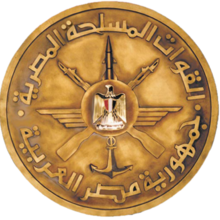Mohamed Naguib
Major General Mohamed Bey Naguib Youssef Qutb El-Qashlan (Arabic: الرئيس اللواء محمد بك نجيب يوسف قطب القشلان, Egyptian Arabic pronunciation: [mæˈħæmmæd næˈɡiːb]; 19 February 1901 – 28 August 1984) was an Egyptian politician and military figure who briefly served as the first President and Prime Minister of Egypt following the establishment of the Arab Republic of Egypt on 18 June 1953.[2] He had served as personal guard to King Farouk I of Egypt and was a distinguished veteran of the 1948 Arab-Israeli War. After the war he became involved in the Free Officers Movement and, along with future president Gamal Abdel Nasser, lead the Egyptian Revolution of 1952 that deposed Farouk and ended the rule of the Muhammad Ali Dynasty in Egypt and Sudan.[3]
Mohamed Naguib محمد نجيب | |
|---|---|
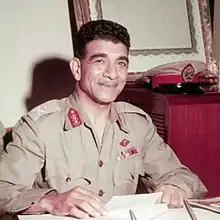 | |
| 1st President of Egypt | |
| In office 18 June 1953 – 14 November 1954 | |
| Prime Minister | Himself Gamal Abdel Nasser |
| Preceded by | Fuad II (as King of Egypt and the Sudan) |
| Succeeded by | Gamal Abdel Nasser |
| 30th Prime Minister of Egypt | |
| In office 8 March 1954 – 18 April 1954 | |
| President | Himself |
| Preceded by | 1st President of Egypt |
| Succeeded by | Gamal Abdel Nasser |
| In office 17 September 1952 – 25 February 1954 | |
| Monarch | Fuad II (until 18 June 1953) |
| President | Himself (from 18 June 1953) |
| Preceded by | Ali Maher |
| Minister of War and Navy | |
| In office 17 September 1952 – 18 June 1953 | |
| Prime Minister | Himself |
| Preceded by | Ali Maher |
| Succeeded by | Abdel Latif Boghdadi |
| Personal details | |
| Born | 19 February 1901 Khartoum, Anglo-Egyptian Sudan, British Empire |
| Died | 28 August 1984 (aged 83) Cairo, Egypt |
| Cause of death | Liver cirrhosis |
| Nationality | Egyptian |
| Political party | Military/Liberation Rally |
| Spouse(s) | Aziza M. Labib (died in 1971) |
| Awards | Order of the Nile Order of the Republic |
| Signature | |
| Military service | |
| Allegiance | |
| Branch/service | |
| Years of service | 1918–1954 [1] |
| Rank | |
| Unit | Infantry |
| Battles/wars | 1948 Arab-Israeli War |
Early life
Mohamed Naguib was born on 19 February 1901 in Khartoum, Anglo-Egyptian Sudan to Youssef Naguib and Zohra Ahmed Othman.[4] Zohra was a Sudanese local, while Youssef was a ranking officer of the Egyptian Armed Forces who had come from a notable Egyptian family of army officers. Naguib was the eldest of nine children.
Naguib attended secondary and military school at Gordon Memorial College in Khartoum, graduating in 1918. He joined the Egyptian Royal Guard in 1923. In 1927, Naguib became the first Egyptian military officer to obtain a law license. In 1929 he earned a postgraduate degree in political economy, and then another postgraduate degree in civil law in 1931.[5]
Military career
In December 1931, Naguib was promoted to the rank of Captain. He moved to the border patrol in El-Arish in 1934. He was part of the Military committee that carried out the terms of the Anglo-Egyptian Treaty of 1936. In Khartoum, he founded a newspaper for the Egyptian Armed Forces in 1937, and he achieved the rank of Major on 6 May 1938.[6]
Naguib tendered his resignation in protest following the Abdeen Palace incident of 1942. Naguib wrote in his autobiography that he had resigned because he had broken his oath of allegiance to the King by failing to prevent the British siege of the palace, but that Abdeen Palace officials thanked him for his actions regardless and refused to accept his resignation.[7]
Naguib subsequently continued his upward trajectory through the hierarchy of the Egyptian military, achieving the rank of Lieutenant Colonel and the post of Regional Governor of the Sinai Peninsula in 1944. He took on leadership of the mechanized infantry of the Sinai in 1947, and was promoted to Brigadier General in 1948.[8]
Naguib achieved great distinction during the 1948 Arab-Israeli War, where he was wounded seven times. For his service he was awarded the first military star of Fuad as well as the title of Bey. He was also subsequently awarded with the directorship of the Military Academy in Cairo, where he would ultimately encounter the Free Officers Movement.[9]
Free Officers Movement
Mohamed Naguib was first introduced to the Free Officers Movement by Abdel Hakim Amer during his tenure as the director of the Cairo Military Academy. The Free Officers were opposed to the role of the British Empire in Egyptian Politics, and also wanted to convert the Kingdom of Egypt from a monarchy into a Republic State.
The movement had been composed exclusively of servicemen who were all under thirty-five years of age and from low-income backgrounds, and it had been lead early on by Gamal Abdel Nasser. Nasser felt that the movement needed an older officer from a distinguished military family in order to be taken seriously, and thus recruited Naguib into the movement. While this proved successful in strengthening the Free Officers, it would later cause great friction and a power struggle between the two men. Historians have argued that Naguib's leadership role was merely that of a figurehead, due to his limited role in the movement.[10]
Revolution of 1952
On 23 July 1952 at about 1AM, the Free Officers launched a coup d'état to depose King Farouk. Naguib was not a member of the executive committee of the Free Officers, and first learned of the coup only several hours after it had begun.[11] Naguib was immediately appointed as Commander in Chief of the Army in order to keep the loyalty of the Armed Forces firmly behind the junior officers' coup. His jovial personality and his elder status also made him appear as a reassuring figure to the Egyptian public, who had not previously been exposed to Nasser and the Free Officers Movement.[11]
The Free Officers chose to rule at first via Aly Maher Pasha, a former Prime Minister who was known for his anti-British views.[11] Naguib's most important in the coup was thus to liaise with the British, and the next evening Naguib was dispatched to meet with British diplomat John Hamilton.[12] During the meeting Hamilton assured Naguib that Britain supported the abdication of King Farouk; that the Churchill government viewed the coup as an internal Egyptian matter; and that Britain would intervene only if it felt that British lives and property in Egypt were in danger.[12]
The prospect of British intervention on behalf of King Farouk was the biggest threat to the Free Officers Movement, and Hamilton's message to Naguib gave the Free Officers the reassurance they needed to follow through with deposing Farouk.[12] On the morning of 26 July 1952, Maher arrived at the Ras El Tin Palace where Farouk was staying in order to present him with an ultimatum from Naguib: He was to abdicate his throne and leave Egypt by 6PM the following day, or the Egyptian troops gathered outside of Ras El Tin would storm the palace and execute him.[13] Farouk agreed to the terms of the ultimatum, and the following day in the presence of Maher and American ambassador Jefferson Caffery boarded the Mahrousa and left Egypt.[13] Naguib arrived late at the Mahrousa's dock, and according to Caffery was angry about missing Farouk's departure.[13]
In September, Naguib was appointed Prime Minister of Egypt and a member of the Royal Regent Council, with Nasser serving in the background as the Minister of Interior. Naguib also permitted Fuad II to succeed his father Farouk as King of Egypt. The succession was designed to deny the British a pretext for intervention, allowing the revolutionaries to maintain that they were opposed only to the corrupt regime of Farouk, and not to the monarchy itself. However, after consolidating their power, the Free Officers quickly moved to implement their long-held plans for abolishing the monarchy. Ali Maher's government resigned on 17 September 1952 and Naguib was appointed Prime Minister. On 18 June 1953, almost 11 months after the revolution, Naguib stripped Fuad of his title and officially declared the end of the Kingdom of Egypt and the establishment of the Arab Republic of Egypt.
Presidency and resignation
With the declaration of the Republic, Naguib was sworn in as its President. However, in late 1953, Nasser accused Naguib of supporting the recently outlawed Muslim Brotherhood and of harboring dictatorial ambitions. A brief power struggle broke out between Naguib and Nasser for control of the military and of Egypt. Nasser ultimately won the struggle and managed to force Naguib to resign from the presidency of Egypt in November 1954. Nasser then placed Naguib under informal House Arrest in a suburban Cairo villa owned by Zeinab Al-Wakil, the wife of former Prime Minister Mustafa El-Nahas. Naguib was released from his House Arrest in 1972 by President Anwar Sadat.
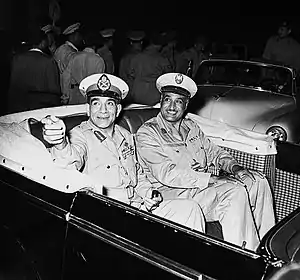 Naguib (left) and Gamal Abdel Nasser (right) during celebrations for the second anniversary of the revolution, July 1954
Naguib (left) and Gamal Abdel Nasser (right) during celebrations for the second anniversary of the revolution, July 1954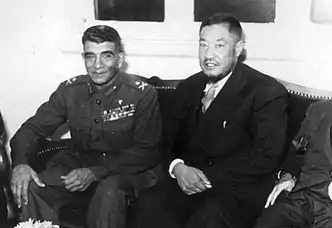 President Mohamed Naguib with Chinese Muslim Kuomintang National Revolutionary Army General Ma Bufang
President Mohamed Naguib with Chinese Muslim Kuomintang National Revolutionary Army General Ma Bufang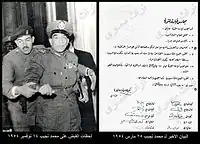 Last declaration by Mohamed Naguib before his arrest 1954
Last declaration by Mohamed Naguib before his arrest 1954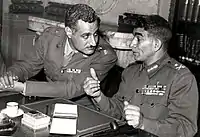
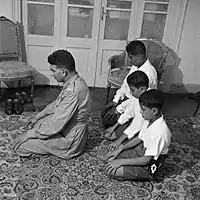 Muhammad Naguib praying with sons
Muhammad Naguib praying with sons The First President of Egypt
The First President of Egypt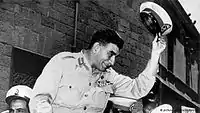 Naguib in 1952
Naguib in 1952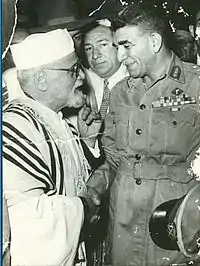 Haim Nahum & Muhammad Naguib
Haim Nahum & Muhammad Naguib
Death
On 28 August 1984, Naguib died from liver cirrhosis in Cairo, Egypt. He was 83. Naguib had a military funeral that was attended by President Hosni Mubarak.
Legacy
Shortly before his death in 1984, Naguib published his memoirs under the title I Was a President of Egypt. The book was widely circulated and was also translated into English under the title Egypt's Destiny. A station of the Cairo Metro is named in his honor. A major road in the Al Amarat District of Khartoum is also named after him.
In December 2013, Interim Egyptian President Adly Mansour posthumously awarded Naguib the Order of the Nile, the highest honor of the Egyptian state. The award was received by his son, Mohamed Yusuf.
See also
- 1952 Egyptian coup d'état
- List of rulers of Egypt
- Gamal Abdel Nasser
Citations
- "ذاكرة مصر المعاصرة - السيرة الذاتية". Modern Egypt. Retrieved 22 December 2012.
- كنت رئيسا لمصر الفصل السابع
- الأوراق السرية لمحمد نجيب صـــ5
- "Muhammad Naguib". Encyclopedia Britannica. Retrieved 22 December 2012.
- كنت رئيسا لمصر صــ195 و270
- الأوراق السرية لمحمد نجيب صـــ11
- كنت رئيسا لمصر صـــ61
- الأوراق السرية لمحمد نجيب صـــ11
- الأوراق السرية لمحمد نجيب صـــ11
- Thornhill 2004, p. 892.
- Thornhill 2004, p. 894.
- Thornhill 2004, p. 895.
- Thornhill 2004, p. 898.
Sources
- Thornhill, Michael. "Britain, the United States and the Rise of an Egyptian Leader: The Politics and Diplomacy of Nasser's Consolidation of Power, 1952–4", pages 892–921 from The English Historical Review, Volume 119, No. 483, September 2004.
Further reading
- Mohammed Naguib, Egypt's Destiny (London, 1955)
External links
| Wikimedia Commons has media related to Mohamed Naguib. |
| Political offices | ||
|---|---|---|
| Preceded by Fouad II as King of Egypt and the Sudan |
Head of state of Egypt 1953–1954 |
Succeeded by Gamal Abdel Nasser |
| New title |
President of Egypt 1953–1954 | |
| Preceded by Ali Maher |
Prime Minister of Egypt 1952–1954 | |
